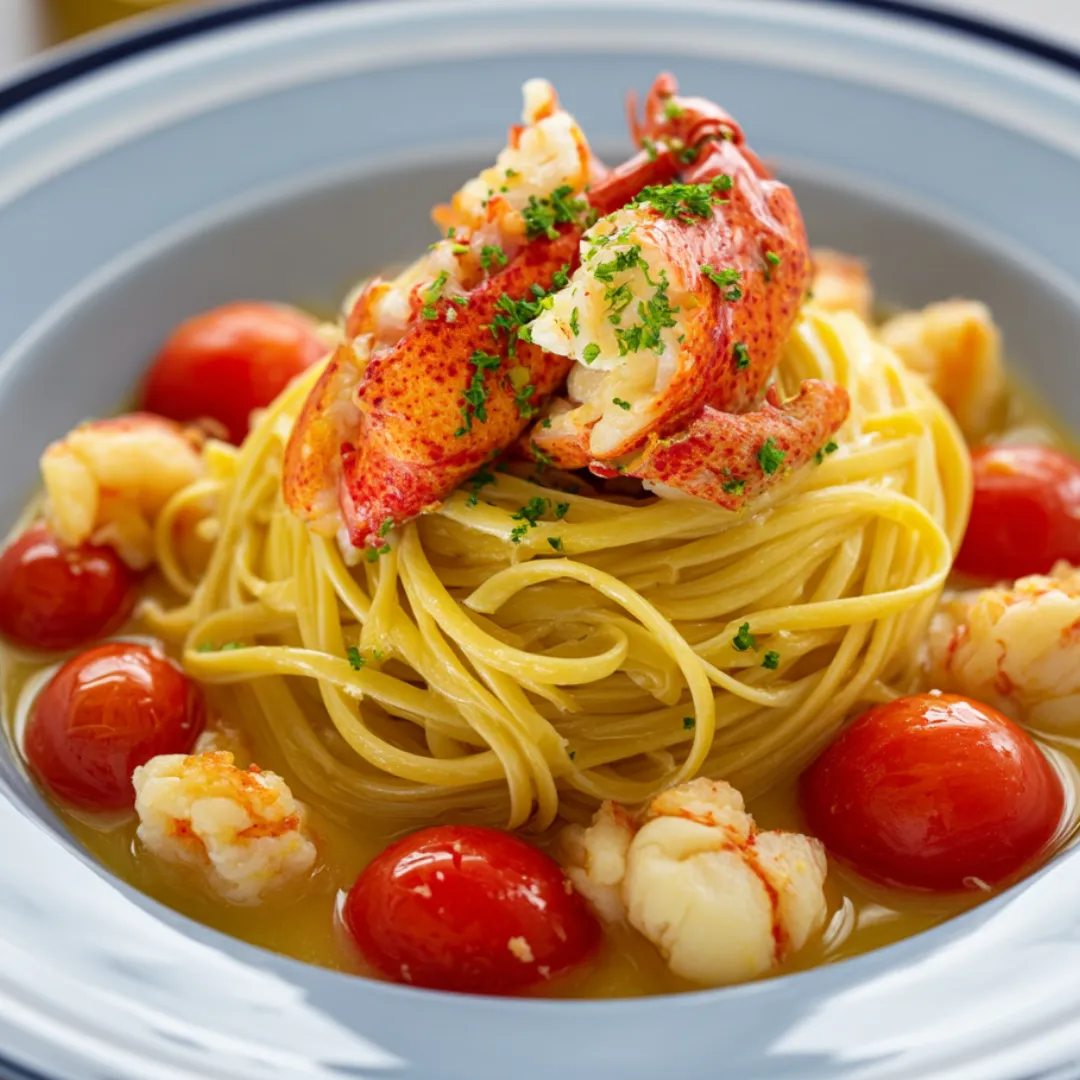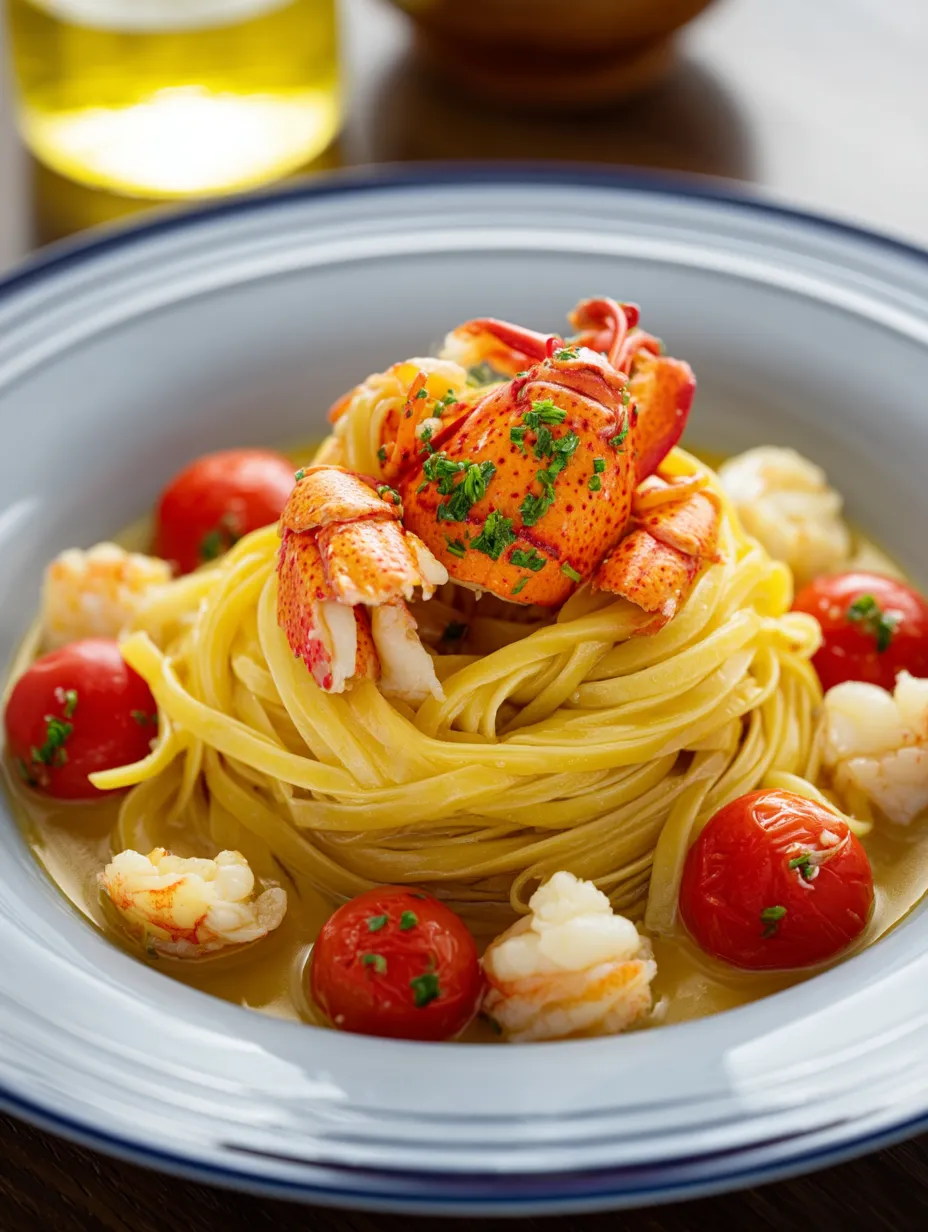 Save Pin
Save Pin
Picture yourself spinning pasta around your fork, each strand glazed with a smooth, buttery coating, catching bits of juicy lobster with every twist. This butter-kissed lobster pasta turns basic items into a fancy dinner you'd think came from a high-end restaurant. The creamy, garlicky sauce hugs each noodle while letting the lobster's mild sweetness take center stage. It's the type of meal that adds magic to regular nights and makes celebrations extra special, yet it's surprisingly easy to whip up in your home.
I cooked this for my husband when he turned another year older, and he swore it was just as good as our go-to seafood spot. What really made it cool was seeing his face light up when he realized I hadn't spent hours slaving away to make something this fancy. My sister stopped by recently – she always says seafood isn't her thing – but after one reluctant taste, she was asking me how to make it before we'd even finished eating!
Key Components
- Lobster tails: Go for cold water ones with clear, firm meat that smells like the ocean; steer clear of any with odd colors or fishy smells. You'll need 4 tails (4-6 ounces each).
- Good pasta: Grab long types like linguine or fettuccine since they soak up the sauce wonderfully; fresh is awesome but regular dried Italian works great too. You'll need 12 ounces.
- Rich butter: The European kind has more fat which makes a creamier sauce with deeper taste; pick unsalted so you can control how salty your dish is. You'll need 6 tablespoons.
- Real garlic: Chop it right before cooking for the strongest flavor; the stuff in jars just doesn't smell or taste the same. You'll need 4 cloves.
- Real Parmesan cheese: True Parmigiano-Reggiano freshly grated off the block melts better and adds depth that the pre-shredded stuff can't touch. You'll need ½ cup.
 Save Pin
Save Pin
Easy Cooking Walkthrough
- Step 1:
- Get your lobster ready – Fill a big pot with 4 quarts water and 1 tablespoon salt, then bring it to a full boil. Drop in 4 lobster tails and let them cook for 4-5 minutes until they turn bright red and the meat looks white but stays soft. Quickly move them to ice water to stop them cooking more, which keeps the meat from getting tough. When they're cool enough to touch, use scissors to cut the soft underside of the shell, then pull out the meat in one piece if you can. Cut it into half-inch thick pieces.
- Step 2:
- Cook your pasta just right – In a big pot with lots of salt (4 quarts water, 1 tablespoon salt), cook 12 ounces of linguine or fettuccine for a bit less time than the box says (about 8-10 minutes for dried stuff). We're making it slightly firm because it'll keep cooking in the sauce, soaking up flavors and releasing starch that thickens everything up. Before you drain it, save ½ cup of the cooking water.
- Step 3:
- Start your flavor base – While pasta's cooking, warm up a big skillet over medium heat. Toss in 2 tablespoons of that fancy butter and 2 tablespoons olive oil, letting the butter melt but not brown. Add 4 chopped garlic cloves and cook for 30-45 seconds until they smell amazing, stirring the whole time so they don't brown and get bitter. Low heat lets the garlic really flavor the fats without burning.
- Step 4:
- Build your sauce – Add your cooked lobster pieces to the garlic butter mix, gently turning to coat each piece. Cook just 1-2 minutes – remember, the lobster's already done and just needs warming. Pour in ½ cup chicken or seafood broth and let it bubble for about 2 minutes to cook down a bit. This creates your sauce base while adding depth. If you want, add ¼ cup heavy cream and let it simmer another minute to thicken slightly.
- Step 5:
- Make it rich – Turn the heat down to medium-low and slowly add ½ cup freshly grated Parmesan while constantly stirring. Adding it gradually stops clumps and keeps things smooth. Squeeze in 1 tablespoon fresh lemon juice to cut through the richness and brighten everything up. Season with ½ teaspoon salt, ¼ teaspoon black pepper, and a tiny pinch of red pepper flakes if you want, tasting as you go to get it just right.
- Step 6:
- Get the texture perfect – When your sauce coats the back of a spoon, add your drained pasta straight to the skillet. Use tongs to gently toss everything together, letting the pasta finish cooking and soak up all that flavor. If things look too thick, splash in some of that pasta water you saved (start with 2 tablespoons) – the starch in it helps the sauce stick to the pasta instead of just making it watery.
- Step 7:
- Add the finishing touch – Just before serving, drop in that last tablespoon of butter and let it melt into the hot pasta. This little trick makes your sauce look shiny and feel super smooth in your mouth. Toss once more to spread that melted butter throughout.
- Step 8:
- Serve it up right – Wind big portions onto warm plates (cold ones will make your sauce get stiff), letting some lobster pieces sit on top so they show. Sprinkle with 2 tablespoons fresh chopped parsley and a little extra Parmesan. Eat right away while everything's at its creamiest.
Lobster always scared me until my grandma from New England showed me how easy it can be. She taught me that less is more – lobster needs gentle heat and minimal fussing to really shine. My dad, who rarely says nice things about food, went completely quiet when he first tried this pasta. He looked up and just said, "This is what butter was made for." Now we make it whenever we're celebrating something, even small wins seem worth it with this dish.
Smart Wine Matches
This rich buttery lobster pasta needs a wine that works with its luxury feel but also cuts through all that richness. Try a bright, unoaked Chardonnay that's got enough body to stand up to the butter sauce while its tartness refreshes your mouth between bites. For something extra nice, grab a glass of Chablis (it's a French Chardonnay) with its flinty quality that really brings out the lobster's sweetness.
If you're more into red wine, this is one of the few seafood dishes that can handle a light Pinot Noir. Its brightness and subtle earthy notes won't drown out the delicate lobster but still match up to the rich sauce.
Swap In Other Seafood Options
While lobster makes this dish super fancy, other seafood works great too. Big sea scallops (8-10 ounces), quickly seared on each side until barely opaque, make a classy swap with a similar sweet taste. Or you could use 8 ounces of jumbo shrimp with just tiny tweaks – cook them for only about 2 minutes in hot water since they cook faster than lobster.
For a cheaper option that still feels special, try mixing 4 ounces shrimp with 4 ounces of tiny bay scallops. The different textures and matching flavors keep things interesting while still feeling fancy.
 Save Pin
Save Pin
Seasonal Twists
Though the beauty of this dish is its simplicity, you can add seasonal touches for nice variations. In spring, toss in ½ cup blanched asparagus tips or fresh peas during the last minute of cooking for color and sweetness. Summer calls for a handful of ½ cup halved cherry tomatoes just warmed through but not mushy.
For fall and winter versions, try adding 4-5 sage leaves crisped in butter as a topping, or mix in ¼ cup butternut squash puree into your sauce for subtle sweetness and body.
I've made this buttery lobster pasta for everything from anniversary dinners to "hey, we made it through the week" Friday meals. There's something magical about how it turns an ordinary night into something special. What makes this dish wonderful is its honesty – simple stuff handled with care. It reminds me that fancy food isn't always about complicated steps or expensive ingredients, but about taking time to enjoy amazing flavors. When life gets crazy, there's something calming about making something so straightforward yet so special. It's become my way of saying "you matter" to people I share it with, including myself.
Common Recipe Questions
- → Can I use frozen lobster tails?
- Absolutely! Just let them thaw in your fridge overnight before cooking. If you've got pre-cooked frozen lobster meat, simply thaw it and warm it up in the sauce for a minute or two.
- → What pasta shape works best with this dish?
- Pasta like linguine, fettuccine or spaghetti grabs the buttery sauce really well. But don't worry if you've got shorter pasta like penne or fusilli - they'll work just fine too.
- → How do I know when lobster is cooked properly?
- When lobster is done right, it turns white with some red spots and feels firm but still tender. It should come out of the shell without a fight. Cook it too long and it'll turn tough and rubbery.
- → What can I substitute for the heavy cream?
- You don't really need the cream. For something lighter, just leave it out and add a bit more pasta water to make your sauce. If you can't do dairy, try coconut cream instead, but it'll taste a bit different.
- → What can I serve with lobster pasta?
- A basic green salad with some tangy dressing works great with this rich pasta. Some garlic bread or a fresh baguette is awesome too for soaking up all that tasty sauce.
